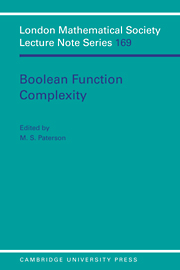Book contents
- Frontmatter
- Contents
- Preface
- List of Participants
- Relationships Between Monotone and Non-Monotone Network Complexity
- On Read-Once Boolean Functions
- Boolean Function Complexity: a Lattice-Theoretic Perspective
- Monotone Complexity
- On Submodular Complexity Measures
- Why is Boolean Complexity Theory so Difficult?
- The Multiplicative Complexity of Boolean Quadratic Forms, a Survey
- Some Problems Involving Razborov-Smolensky Polynomials
- Symmetry Functions in AC° can be Computed in Constant Depth with Very Small Size
- Boolean Complexity and Probabilistic Constructions
- Networks Computing Boolean Functions for Multiple Input Values
- Optimal Carry Save Networks
Networks Computing Boolean Functions for Multiple Input Values
Published online by Cambridge University Press: 23 September 2009
- Frontmatter
- Contents
- Preface
- List of Participants
- Relationships Between Monotone and Non-Monotone Network Complexity
- On Read-Once Boolean Functions
- Boolean Function Complexity: a Lattice-Theoretic Perspective
- Monotone Complexity
- On Submodular Complexity Measures
- Why is Boolean Complexity Theory so Difficult?
- The Multiplicative Complexity of Boolean Quadratic Forms, a Survey
- Some Problems Involving Razborov-Smolensky Polynomials
- Symmetry Functions in AC° can be Computed in Constant Depth with Very Small Size
- Boolean Complexity and Probabilistic Constructions
- Networks Computing Boolean Functions for Multiple Input Values
- Optimal Carry Save Networks
Summary
Abstract
Let f be an arbitrary Boolean function depending on n variables and let A be a network computing them, i.e., A has n inputs and one output and for an arbitrary Boolean vector a of length n outputs f(a). Assume we have to compute simultaneously the values f(a1), …,f(ar) of f on r arbitrary Boolean vectors a1, …,ar. Then we can do it by r copies of A. But in most cases it can be done more efficiently (with a smaller complexity) by one network with nr inputs and r outputs (as already shown in Uhlig (1974)). In this paper we present a new and simple proof of this fact based on a new construction method. Furthermore, we show that the depth of our network is “almost” minimal.
Introduction
Let us consider (combinatorial) networks. Precise definitions are given in [Lu58, Lu65, Sa76, We87]. We assume that a complete set G of gates is given, i.e., every Boolean function can be computed (realized) by a network consisting of gates of G. For example, the set consisting of 2-input AND, 2-input OR and the NOT function is complete. A cost C(Gi) (a positive number) is associated with each of the gates Gi ∈ G. The complexity C(A) of a network A is the sum of the costs of its gates. The complexity C(f) of a Boolean function f is defined by C(f) = min C(A) where A ranges over all networks computing f.
By Bn we denote the set of Boolean functions {0, l}n → {0, 1}.
- Type
- Chapter
- Information
- Boolean Function Complexity , pp. 165 - 173Publisher: Cambridge University PressPrint publication year: 1992
- 1
- Cited by

